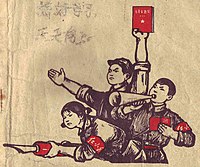
Back Rooi Garde Afrikaans الحرس الأحمر (الصين) Arabic Хунвейбіны Byelorussian Хунвейбин Bulgarian Guàrdia Roja (Xina) Catalan Rudé gardy Czech Den Røde Garde (Kina) Danish Rote Garden (China) German Ruĝaj gardistoj Esperanto Guardias rojos (China) Spanish
| Red Guards | |
|---|---|
 Propaganda poster depicting Red Guards | |
| Founder | Chairman Mao Zedong |
| Leaders | Cultural Revolution Group (until 1968) |
| Foundation | 1966 |
| Dissolved | 1968 |
| Country | China |
| Allegiance | Mao Zedong (ceremonial figurehead) |
| Motives | Preserving the revolutionary ideology of Mao Zedong and his position within the Chinese Communist Party |
| Active regions | Throughout much of China, particularly in Beijing and other urban areas |
| Ideology | Maoism |
| Political position | Far-left |
| Notable attacks | Red August (including the Daxing Massacre, the Guangxi Massacre, the Inner Mongolia incident; the Guangdong Massacre; the Yunnan Massacres; and the Hunan Massacres) |
| Status | Forcefully suppressed by the PLA |
| Size | 11 to 12 million high school and university students, among other followers or supporters[1][2] |
| Red Guards | |||||||||||||
|---|---|---|---|---|---|---|---|---|---|---|---|---|---|
 Red Guards on Tiananmen Square in Beijing. They were holding the "Little Red Book" containing quotations from Mao Zedong. | |||||||||||||
| Simplified Chinese | 红卫兵 | ||||||||||||
| Traditional Chinese | 紅衛兵 | ||||||||||||
| Hanyu Pinyin | Hóngwèibīng | ||||||||||||
| |||||||||||||
| Part of a series on |
| Maoism |
|---|
 |
The Red Guards (Chinese: 红卫兵; pinyin: hóng wèibīng) were a mass, student-led, paramilitary social movement mobilized by Chairman Mao Zedong in 1966 until their abolition in 1968, during the first phase of the Cultural Revolution, which he had instituted.[3]
According to a Red Guard leader, the movement's aims were as follows:
Chairman Mao has defined our future as an armed revolutionary youth organization .... So if Chairman Mao is our Red-Commander-in-Chief and we are his Red Guards, who can stop us? First we will make China Maoist from inside out and then we will help the working people of other countries make the world red ... and then the whole universe.[4]
Despite meeting with resistance early on,[citation needed] the Red Guards received personal support from Mao, and the movement rapidly grew. The movement in Beijing culminated during the "Red August" of 1966, which later spread to other areas in mainland China.[5][6] Mao made use of the group as propaganda and to accomplish goals such as seizing power and destroying symbols of China's pre-communist past ("Four Olds"), including ancient artifacts and gravesites of notable Chinese figures. Moreover, the government was very permissive of the Red Guards, and even allowed the Red Guards to inflict bodily harm on people viewed as dissidents. The movement quickly grew out of control, frequently coming into conflict with authority and threatening public security until the government made efforts to rein the youths in, with even Mao himself finding the leftist students to have become too radical.[7] The Red Guard groups also suffered from in-fighting as factions developed among them. By the end of 1968, the group as a formal movement had dissolved with many of the red guards sent to rural areas and country side due to the Down to the Countryside Movement.
- ^ Cite error: The named reference
autogenerated1was invoked but never defined (see the help page). - ^ Meisner, p. 340
- ^ Teiwes
- ^ Chong, Woei Lien (2002). China's Great Proletarian Cultural Revolution: Master Narratives and Post-Mao Counternarratives. Rowman & Littlefield. ISBN 978-0742518742 – via Google Books.
- ^ Wang, Youqin (2001). "Student Attacks Against Teachers: The Revolution of 1966" (PDF). The University of Chicago. Archived (PDF) from the original on 17 April 2020.
- ^ Jian, Guo; Song, Yongyi; Zhou, Yuan (2006). Historical Dictionary of the Chinese Cultural Revolution. Scarecrow Press. ISBN 978-0-8108-6491-7. Archived from the original on 11 June 2020. Retrieved 10 July 2020.
- ^ MacFarquhar, Roderick; Schoenhals, Michael (2006). Mao's Last Revolution. The Belknap Press. ISBN 978-0674023321.